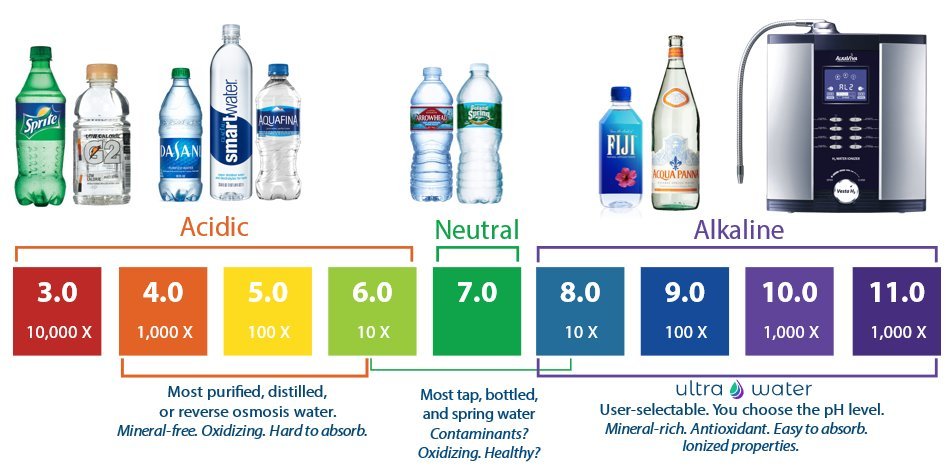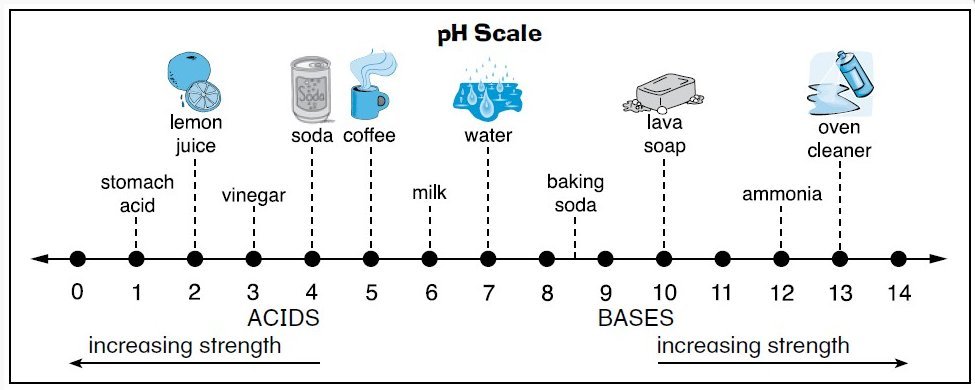Leaderboard
Popular Content
Showing content with the highest reputation on 05/28/20 in all areas
-
I knew if I looked at Wikipedia long enough I would eventually find something you don't need need to stand on three encyclopedias and a dictionary to read. Today I found it so here it is pH is a scale that runs from very acid @1ish to very alkaline also called basic @ nearly 14. Here are some values in relation to common things. The last one is interesting becasue it shows the range of pH we can safely drink.2 points
-
In water sciences alkalinity typically refers to overall buffer capacity rather than pH itself, which is a measure of proton concentration. So if you have low alkalinity, small addition of acid would rapidly decrease pH for example. The main buffer in most environmental systems (and our body) is bicarbonate but other dissolved species can also contribute.2 points
-
Just to be extra clear - the scenario can of course be treated via GR, it’s just that it’s not possible to do so via pen-and-paper methods. You would need to feed this into specialised software, and let a computer run the numbers. I do not have access to such software, so I can’t give you an outright answer to your original question. You are right, it is a pretty fundamental problem - but many fundamental problems in physics can only be solved numerically. Even in simple Newtonian gravity, if there are more than 2 gravitating bodies, the system can only be treated numerically. It is actually not surprising to me at all that this can’t be done on paper, given that the Einstein equations are a system of 16 highly nonlinear, coupled, partial differential equations. It’s more surprising to me that it can be done if one of the two masses is negligible, giving the Aichlburg-Sexl ultraboost solutions. Spacetime curvature overall is a rank-4 tensorial quantity, the Riemann curvature tensor - it describes how geodesics deviate in any arbitrary 4-dimensional spacetime. Time dilation is only a subset of that geometrical information; essentially, you can think of time dilation as ‘curved time’, and tidal gravity as ‘curved space’. Unless you have very special, highly symmetric circumstances (as e.g. in Schwarzschild spacetime), you cannot separate these two aspects - which is why, after taking account of all the various index symmetries, there are a total of 20 functionally independent components in the Riemann tensor, and you need them all to uniquely determine all aspects of a spacetime’s geometry in the general case. Time dilation alone is not enough, i.e. you can’t replace a rank-4 object that has 20 functionally independent components with just one scalar quantity, and expect to be able to capture the same information. So the answer is no, for the general case you cannot separate time dilation from the rest of your spacetime’s geometry in any meaningful way. This being said, as you introduce symmetries into your spacetime, the amount of information required to uniquely determine its geometry decreases. For Schwarzschild spacetime, you are dealing with a highly special case that is spherically symmetric, static, stationary, a vacuum, and asymptotically flat. Because it admits a time-like Killing vector field, you are able to define the notion of ‘gravitational potential’ here - the Schwarzschild geometry then simply is a family of nested surfaces (spheres) of gravitational equipotential. So for this special case, you can in fact write down a scalar field that is simply a gravitational potential with respect to some reference point (usually the center of the gravitating mass). But this is only possible because Schwarzschild spacetime is so highly symmetric - this does not generalise to more general spacetime, and most certainly not to the set of all possible spacetimes. And even then, the simple-looking form of the Schwarzschild metric is somewhat deceptive, because once you do actual calculations with it (e.g. how long it takes for a test particle to fall along a certain trajectory), things can become fairly complicated fairly quickly, since you need to integrate the relevant parts of the line element.2 points
-
One problem is the rate of change. Evolution and adaptation is a very, very slow process. If environmental change happens too fast then there is no chance to adapt. And we know that the current changes are happening faster than at at any time in the past. I find it strange that those whose political ideologies are aligned with using natural resources are so often opposed to managing those resources. I am sorry, but after Brexit (a campaign run by an elite group of billionaires and public schoolboys in politics and the media) I find accusations against "the liberal elite" ludicrous. It has become the modern "political correctness" - a pathetic and meaningless insult to throw at people who you disagree with. In what sense are academics (who are experts because they have spent their careers studying a subject) "elite"? Even if they are "liberal" (gasp!!!) they are not in charge. They provide information and advice. It is up to governments to take action. The UK has one of the most extreme right wing governments for decades. Not one of them could be described as "liberal elite"; they are just elite - rich, entitled and not terribly clever. But even they see the need for lockdown (even if a little too late so they have killed many thousands of people). You may think you are incredibly strong, brave and street-smart (none of that stupid book-learning for me, thank you very much) but viruses don't care. You might be young, white and healthy, and therefore at low risk. But your selfish desire for "personal freedom" means you would put others at risk. If you think your personal freedom is more important than other people's survival then that makes you you are the "liberal elite". Nice goalpost shifting. "If Elk are in danger; they can just move" "So what if they can't move, who cares about them anyway"2 points
-
The consistency of stupid claims being made by certain members in this thread is rather impressive. For those curious about adaptation of plants and animals, see here: https://skepticalscience.com/Can-animals-and-plants-adapt-to-global-warming.htm For those wondering if CO2 is just plant food anyway, try this one: https://skepticalscience.com/co2-plant-food-basic.htm2 points
-
'Africans are used to the heat it won't bother them, and we can send them more food if they need it. That way the population of Africa can continue growing and natural resources can be continue being extracted and shipped here cheaply' I'm not surprised Africa is turning to China when I read patronising crap like this. What decade do you live in? (drumbo)2 points
-
I think we should start from completely different discipline.. (discussion about psychology, psychiatry and philosophy are so so much waste of time anyway) I have a question: if we have virtual world, simulation, or game, with A.I. walking in it, do these A.I. entities have free will.. or they don't have free will.. ? Typical 3D modern game stores location of A.I. bots, players, and items, using 3x floats or 3x doubles, which have (2^32)^3 possible values for float and (2^64)^3 = ~6.28*10^57 possible values for double precision. (similar with other properties i.e. rotation and movement of parts of body, even more greatly increasing the amount of possibilities). If in one version of game/simulation A.I. went one way from point A to B, and in second version, it went completely different way, does it count as free will to choose the path.. ? A.I. typically take the most optimal i.e. the shortest or the quickest path between point A and B. (Human and living organisms, in the most of cases, as well, to conserve energy) If in the real world, somebody went one path, and car (or whatever else) accident happened, it cancelled plans and potentially changed everything further in that person life (including end of life). If somebody would went the other path, or has been delayed by seconds or milliseconds, nothing would happen. The moment of getting out of home, pressing gas pedal, taking that not other path, etc., is under free will of human? If A.i. plays chess, it goes through the all possible to be taken moves, regardless their senselessness, either his/her/its own and opponent moves, and judges them. It is repeated in a loop. And A.I. picks up the most optimal branch of movements, in the given by human/creator time (difficulty level). The most optimal sequence of movements is leading to winning (or has the highest probability of winning) the game i.e. there is used the smallest energy / effort needed to do it. Player of chess predicts movements of opponent and his/her reactions for them. The all variables are on the table (unlike typical world). Do A.I. playing chess have free will.. ? Similarly, living organisms try to do the most optimal actions i.e. the most energetically favorable. If a dog walks down the street and finds meat, catches it and eats. Free meal. No big deal. But if a human would walk the street and found wallet full of money. The most energetic favorable action is taking the money (working to be paid requires spending more energy). In the time of gatherers, prehistoric and ancient times, whatever you found was yours and nobody would object that you 'stole'.. Caveman giving up on free meal that he or she found would be considered fool or crazy. Modern "caveman" taking wallet full of money is considered thief.. ("opportunity makes a thief") Somebody here, or in similar free will thread, showed article where computer was foreseeing what person will do with great precision. A.I. or computer algorithm just analyzed gathered data about a person (or general human behaviors), and output the most energetically favorable actions. I am analyzing you and telling that the most of you would quit the job the next day after winning the lottery with multi-millions award.. Do you have free will in this action? Foreseeing the most energetically favorable actions is easy. Some even divorced prior getting cash from lottery to not have to split award.. LOL! What a "great" example of optimization of energy/greediness.1 point
-
Yes. The atoms in an atomic clock, for example, explicitly experience the effect. It’s not specifically the gravitational force that results in time dilation, it’s the potential - the position in the gravitational field. So a constant g would still result in time dilation for different vertical positions. If your slits were spaced vertically, there would be an effect. Or if you tossed atoms in a superposition, where the two states would go to different heights. Mark Kasevich has done such experiments with his 10m tower.1 point
-
Indeed, and nobody is claiming they are, although your choice of the term 'particles' carries a bit of that connotation. If one quantum particle is sent through a double slit, we observe one point (where it is measured), something a wave sent through the slits will not do. The probability curve of where that measurement will be taken is what resembles an interference pattern. No wave exhibits quantized behavior like that. Sound (an example of an actual wave) passed through slits will be measured in all locations, not just one, and its intensity (yes, an interference pattern) will drop off as a function of distance from source to measurement. A photon or electron exhibits no similar behavior, being measured at full mass/energy at the measurement location and not measured at all at any other location. Sound (or any other real wave) ceases to propagate if you take away its medium. There is no medium for a photon or molecule passing through the slits, and yet they still arrive at the measurement location.1 point
-
1 point
-
1 point
-
I've never owned a pool and I'm not a chemist ( disclaimer ). I've always thought that a pool's pH is kept at a point that is optimal for the 'shock', or oxidizer, that keeps pool water clear. A strong caustic would be used to bring the pH to that optimal range, and buffering would be used to keep the pH from 'wondering' about. Otherwise the oxidizer would break down too quickly, and you would have trouble keeping oxidizer level in a safe range.1 point
-
Some of our properties ( and of our constituents ) can be described by a wave model ( and associated probability distributions ).1 point
-
No, they're not. If measured in the right way, they share some properties with waves, but they also behave in ways that waves definitely do not. This doesn't follow. Just because I'm made up of cells doesn't imply that I am a cell.1 point
-
Nice explain, Markus. Reminds me of QM, where one can take advantage of symmetry in the Hydrogen atom, in spherical polar co-ordinates to reduce the 2nd order partial differential equation and get exact answers. But as soon as asymmetries are included, like you get with multi-electron systems of Helium and higher, the equations become intractable, and must be handled by numerical methods. with the number of EFEs the situation is probably a few orders of magnitude harder in GR. On the 'bright side' ... , the OP's stubbornness to abandon his simplistic idea, has allowed for a lot of these teaching/learning opportunities. And the rest of us who choose to seriously consider the information presented by you, Mordred, and others, are 'richer' for it.1 point
-
Thank you for the great reply's but i already found the answer. It seems that during the centrifugal separation the fruit juice get's diluted by about 15% which explains the drop in conductivity.1 point
-
I think I'm not fully following the reasoning, can you elaborate? How is there a failure of Newton's third law?1 point
-
I'm located at 43.16 N latitude. Last week we had frost warnings at night, so I hadn't taken my lemon tree outdoors yet. This week, after bringing it outside, we've had three days of 35 deg C temperatures so far ( I remember when we had a Spring and fall ). The delicate new growth ( after pruning in March ) is having a tough time adapting to the sudden heat. No doubt there will be considerable adaptation involved with dealing with AGW, but it won't be easy. And losses will vastly outweigh the benefits.1 point
-
You do know there's no point further North of the North Pole, don't you?1 point
-
"Occasionally, an obsession does turn out to be something good." Chen Ning Yang The key word here is "occasionally." "It was a crazy idea, I grabbed the back of a napkin and did the necessary calculations." Murray Gell-Mann The key words here are "necessary calculations."1 point
-
There is a lot being said here regarding getting to know a prof, but I think that this is not the key issue here. The main challenge is that the pitch it unclear and as a researcher I would not see an immediate actionable beneficial path. Ultimately, academics are busy and I would need to know why I should invest time into something incredibly vague. Considering that the pitch is very broad it is not clear what precisely the provided expertise is, who is going to pay for materials and so on. Basically OP is proposing a rough idea and hopes that folks buy into it. But that is generally not going to happen. One will need to make at least some headway into demonstrating that whatever one provides has the potential to be useful and make the investment from the researcher worthwhile. Ultimately, commitment to a collaboration is an investment of time and time is the most limited resource we have. It would help immensely if OP could outline specifics so that folks can look at it and see whether there is potential for them or not. It would also help to inform oneself on already commercialized automations. For example, pipetting robots are very helpful for high-throughput analyses. But they require high precision and are therefore very expensive. Other folks (myself included) also occasionally develop new analytical schemes. We often buy, say pumps, PMTs and so on and try to make them play nice via labview or similar. What new would OP bring to the table in that area, for example? A cold call is in its essence a sales pitch. You are trying to get folks interested in something and considering the time constraints you always need to make it pretty clear what is in for them and what is the expected investment. If you want skills you need be specific in what they are and what you can deliver, for example. The way OP is phrased it basically reads like "I have certain skills, please outline a project to which I could apply them for- I will work on it and at some point (?) we might commercialize it". This is not a very attractive pitch as it does not have a scope or even an outline how one might imagine a collaboration to work. There are various ways to create interest, and I usually only respond when I see at least some way forward. The same will be for most other folks, our inboxes are overflowing and we literally only have a few seconds to deal with such requests otherwise we will never get to the end of the list (and honestly more than a few get lost in the process).1 point
-
Why are you concerned with Elk? They are classified as a least-concern species by the IUCN. https://en.wikipedia.org/wiki/Elk https://en.wikipedia.org/wiki/Least-concern_species-1 points

















